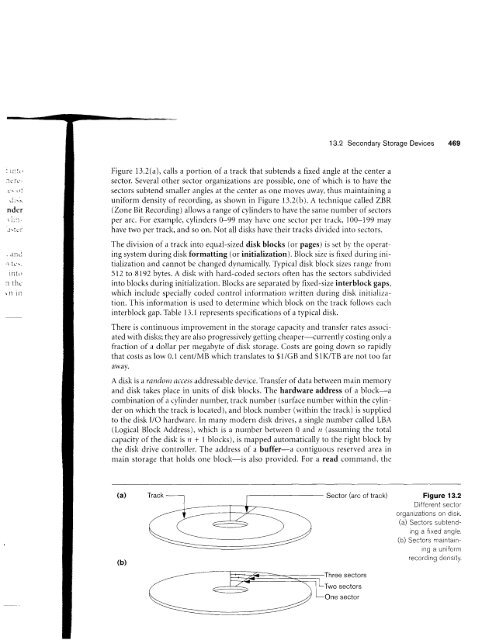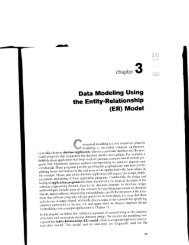13.1 through 13.5, 13.10 and 13.11
13.1 through 13.5, 13.10 and 13.11
13.1 through 13.5, 13.10 and 13.11
Create successful ePaper yourself
Turn your PDF publications into a flip-book with our unique Google optimized e-Paper software.
13.2 Secondary Storage Devicesi\ (rl{rrl i\ -\nderr ll:t-ll thr'\ ll lllFigure 13.2(a), calls a portion of a track that subtends a fixed angle at the center asector. Several other sector organizations are possible, one of which is to have thesectors subtend smaller irngles irt the center as one moves away, thus n-raintaining auniform density of recording, as shown in Figure 13.2(b). A technique called ZBR(ZoneBit Recording) allows a range of cylinders to have the same number of sectorsper arc. For example, cylinders 0-99 may have one sector per track, 100-i99 mayhave two per track, <strong>and</strong> so on. Not all disks have their tracks divided ir-rto sectors.l:icl-llllr)The division of a track into eqr.ral-sized diskblocks (or pages) is set bv tl.re operatingsystem during disk formatting (or initialization). Block size is flxed during initiirlization<strong>and</strong> cannot be changed dynamically.'Iypical disk block sizes ranse fror.r.r512 to 8192 bytes. A disk with hard-coded sectors often has the sectors subdividedinto blocks during initialization. Blocks irre separated by fixed-size interblock gaps,rvhich include specially coded control iufbrmation written during disk initialization.This information is used to determine which block on the track fbllows eachinterblock gap. Table l3.l representspecifications of a typical disk.There is continuous imprrovement in the storage capacity <strong>and</strong> transfel rates associatedwith disks; they are also progressivelv getting cheaper-currently costing only afraction r.r[ a dollar per r-negabyte of disk storage. Costs are going dorvn so rapi{11'that costs as low 0.1 cent/MB which translates to $l/GB <strong>and</strong> $lK/TB are not too fhrarvay.Adiskis ar<strong>and</strong>otn cccessaddressabledevice.Transf'erof databetweenmain menrory<strong>and</strong> disk takes place in units of disk blocks. The hardware address of a block-acombination of a cylinder nunrber, track nun'rber (surfirce number within the cylinderon which the track is located), <strong>and</strong> block number (within the track) is suppliedto the disk I/O hardware. In many modern disk tlrives, a single number called LBA(Logical Block Address), which is a number between 0 <strong>and</strong> rr (assunting the totalcapacity of the disk is rr + I blocks), is mapped automatically to the right block bythe disk drive controller. The acldress of a buffer-a contiguons reserved areir inmain storaqe that holds one block-is also provided. For a read cornn.r<strong>and</strong>, theSector (arc of track) Figure 13.2Different seciororganizations on disk.(a) Sectors subtendinga fixed angle.(b) Sectors maintaininga uniformThree sectorsTwo sectorsOne sectorraeardinndonciirr














